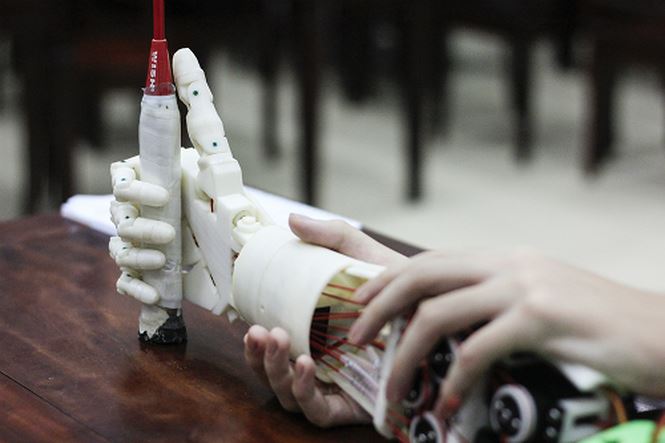
Two eighth-grade schoolboys from Trung Vuong Secondary School in Hanoi have won first prize at the city's 2018 science and technology creativity competition for secondary school students, and a second national prize.
 |
| The mind-controlled robot arm. |
Two eighth-grade schoolboys from Trung Vuong Secondary School in Hanoi have won first prize at the city’s 2018 science and technology creativity competition for secondary school students, and a second national prize.
Anh Khoi, one of the two students, grew up in a family with an uncle who lost his right arm in the war. Cong Huy, the other student, says he has been concerned about more than 2 million Vietnamese with mobility impairments due to war, traffic accidents, labor accidents or congenital diseases.
After three months of intensive research, programming, 3D printing and assembly, the students created a mind-controlled robot arm with four components: the brainwave reader Emotiv Insight, computer with Python program, Adruino circuit and the arm.
When users wear an Emotiv Insight hat and concentrate their attention, they can operate the arm so that it can stretch, bend or hold small objects.
In principle, when users concentrate on thinking, the Emotiv device, which is trained by Khoi and Huy to become used to the user's mind, will read the brain, convert the thoughts into digital signals and transmit wirelessly to a computer.
The computer, which runs on Python, will analyze the signal and send commands to the Adruino circuit. From this command, Ardruino controls servo motors to help move the arm.
Khoi said it took a lot of time to program Python and Adruino. Python links Emotiv and Adruino. “We had to change codes so many times,” he said, adding that it took them three months to program the arm, with VND10 million spent on 3D printing and the Emotiv device.
Emphasizing that the robot arm is still experimental, Huy and Khoi plan to replace the cumbersome computer and Adruino with a compact Raspberry Pi which can be stuck on an arm, and replace the servo motor with an electrical cylinder to help increase the loading capacity of the arm.
Prior to that, Pham Huy, an 11th grader at the Quang Tri High School, won third prize at Intel ISEF 2017 with a robot arm. However, Huy and Khoi still decided to create another arm which they believe is better.
“Pham Huy's robotic arm uses toes to control movements. This is unnatural and cannot be used for people with both paralyzed hands and feet. The arm that we have built can fix this problem,” Khoi explained.
The invention of the two secondary school students surprised everyone. “The jury board raised a lot of questions to check if we were really the inventors,” Khoi said.
“By explaining in details what we did, from programming, printing the arm, assembling and training Emotiv, we could prove that the invention is feasible and practical, though we are just eighth graders,” he said.
(Source: VNN)





